






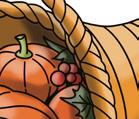
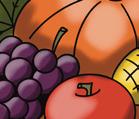







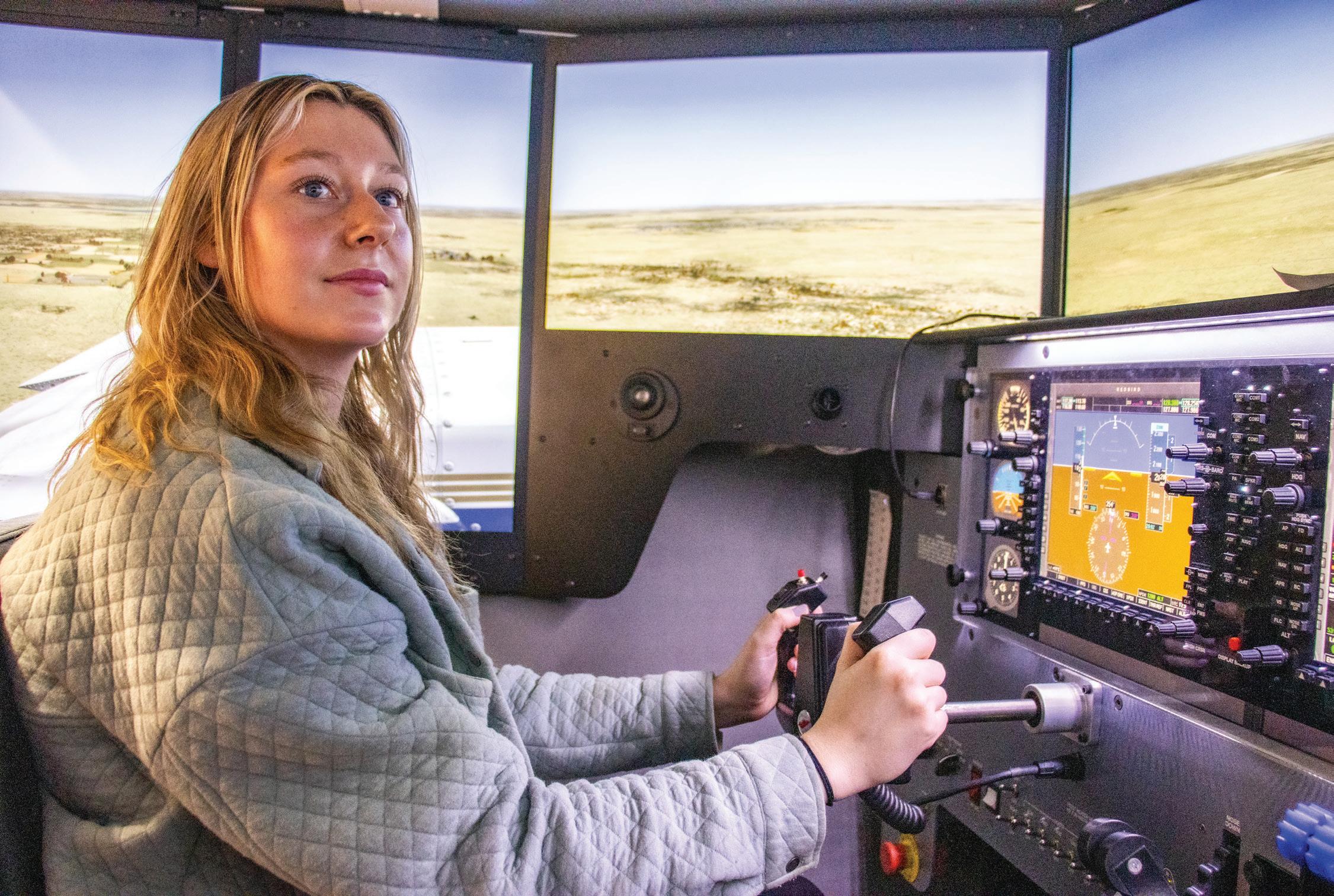


















HUDA QURESHI managing
editor
huda.qureshi@my.tccd.edu
Christopher Anderson’s first solo flight was an adrenaline rush, almost resulting in a crash.
“When you see your life flash before your eyes, you’re like, ‘Maybe I shouldn’t be doing this,’” Anderson said. “I like to be alive, you know.”
But in the end, Anderson still chose the life of a pilot. He went on to pursue a professional pilot degree at TCC’s Center of Excellence for Aviation, Transportation, and Logistics associated with the NW Campus.
The center offers degree opportunities in aviation maintenance, becoming a professional pilot, welding, logistics and supply chain management and non-destructive inspection, testing and evaluation.
It’s a relatively newer looking building with wide-open warehouse space that houses
teaching equipment such as deconstructed plane parts used for hands-on learning. The building is next to Alliance Airport, and students will find themselves flying planes using the same control tower as planes from Amazon Prime or FedEx.
David McGarity, chair of the professional pilot program, said learning how to fly is an amazing process.
“We’re going to turn these people into wizards,” he said. “They’re going to be able to float a ton of metal into the air the first day they come here to learn how to fly. … After two or three months here, they get to the point where they get to solo the airplane and fly all by themselves, without any instructor or anyone else. It’s an accomplishment that they will remember for the rest of their lives.”
As a former commercial pilot himself, McGarity said students can expect a unique workplace.
“You wake up in the morning here in Dallas, and maybe later in the day you’re
in Puerto Rico, and then you’re home again with your family at night,” he said.
Michelle Frantik, coordinator of flight operations, said it can be challenging at first, but after getting past the initial struggles of adjusting to flying a small plane and gaining necessary aviation knowledge, students will find success.
“One of the great things is that when they finish the program, they immediately go from student to flight instructor,” she said. “One day they may be in their khaki pants and polos, which is our uniform as a student, and the next week, they might be in a U.S. Aviation flight instructor uniform teaching the students coming in. So that’s a pretty neat turnaround and not something that happens typically so quickly in other industries.”
There are flight stimulators available for those who are learning how to fly, free of charge to students in the program. These simulators are large machines, resembling a See Aviation, Page 3
FOUSIA ABDULLAHI
editor-in-chief
collegian.editor@tccd.edu
The construction plans for NW, NE, South and SE campuses are all underway, and students can expect to get more greens in their diet with new salad bars being built.
The board approved an amendment of $105,320 to the food service construction contract at its Nov. 14 meeting. The additional funds will be used for front of house renovations, including a fresh salad bar and serving line, at all four campuses.
“It was initially designed for something like a Subway delivery, and today our plan is to offer hot food and a salad bar at each campus,” Anglin said.
Chief Financial Officer Pamela Anglin also requested an amendment to NW Campus construction plans to facilitate changes for NW02 and NW03, including food service improvements and design changes to the bookstore and new copy center.
The upgrades include adding 6G wireless access points. It also includes some redesign for security cameras. These cameras will be 360-degree cameras. Additional construction changes include addressing accessibility issues in the fire training center in NW11 that was originally renovated in 2021. It didn’t meet the Texas accessibility standards due to the main ramp slope being more steep than standard.
“There are also accessibility issues with some of the parking spaces and striping,” Anglin said.
The board approved the contract to remove and replace the old ramp and the concrete work needed in the parking lot for $150,895.39.
Other ongoing construction projects around the district include the South Campus SHPE building’s 60-year-old gym flooring, which needs to be replaced due to a leaking roof. The board approved the motion for $348,700.
“Our first job was to replace our roof on the building, and that was done and completed this past year, and now we’re ready to replace the floor,” Anglin said. “The floor would be completely replaced with Northern maple hardwood.”
Anglin also presented the district financial report for Oct. 31, which shows an expenditure of $91,456,501, and the revenue is $74,582,811.
FOUSIA ABDULLAHI editor-in-chief collegian.editor@tccd.edu
Longtime instructor and coordinator of the culinary program at SE Campus, Chef Katrina Warner helps students achieve their culinary goals. This year, she completed one of her own.
She won the American Culinary Federation’s Chef Educator of the Year award, one of the top prizes in a competition that honors chef educators nationwide.
Warner had to become a certified executive chef to qualify and then went through a lengthy process to win.
Having instructors certified as executive chefs means that when students graduate with their associate degree, they also earn their culinarian certification.
Culinary awards are not new to Warner. She previously won the Texas Chefs Association’s Dallas chapter Educator of the Year in 2019 and state in 2021.
As a teen, she worked in food services, first in multiple areas, including dishwasher, food prep and hotline plating. This solidified her desire to work in the culinary area.
“Food service has always been in my family,” Warner said. “My mother was a home ec teacher for 30 years. My brother is also an executive chef. He went through chef training, and so, I just kind of followed him.”
Warner said she’s passionate about attracting more students to the program. She has focused on creating a well-rounded program so students are familiar with all aspects of food services, including hospitality management.
“It’s been morphed and changed to keep up with all the food service trends that are out there to make sure we are relevant,” Warner said.
She also works to recruit students through dual credit programs in high schools and assorted community outreach initiatives, such as participating in food bank events and taste festivals.
Erika Vargas, a student who had Warner as an instructor about 10 years ago, said she liked her teaching style.
Food service has always been in my family.
Katrina Warner SE Campus culinary instructor
“She’s always been very straight and to the point when it comes to her instruction. There’s no extra fluff if she has it,” Vargas said. Working in food services has multiple layers, like an onion, which also requires thinking about food allergies. Warner and other instructors must adjust based on students’ needs.
“We had a student who was so highly allergic to garlic that we pretty much took it out of any class she was in just so she wouldn’t have a reaction,” Warner said.
SE Campus president Andy Bowne said
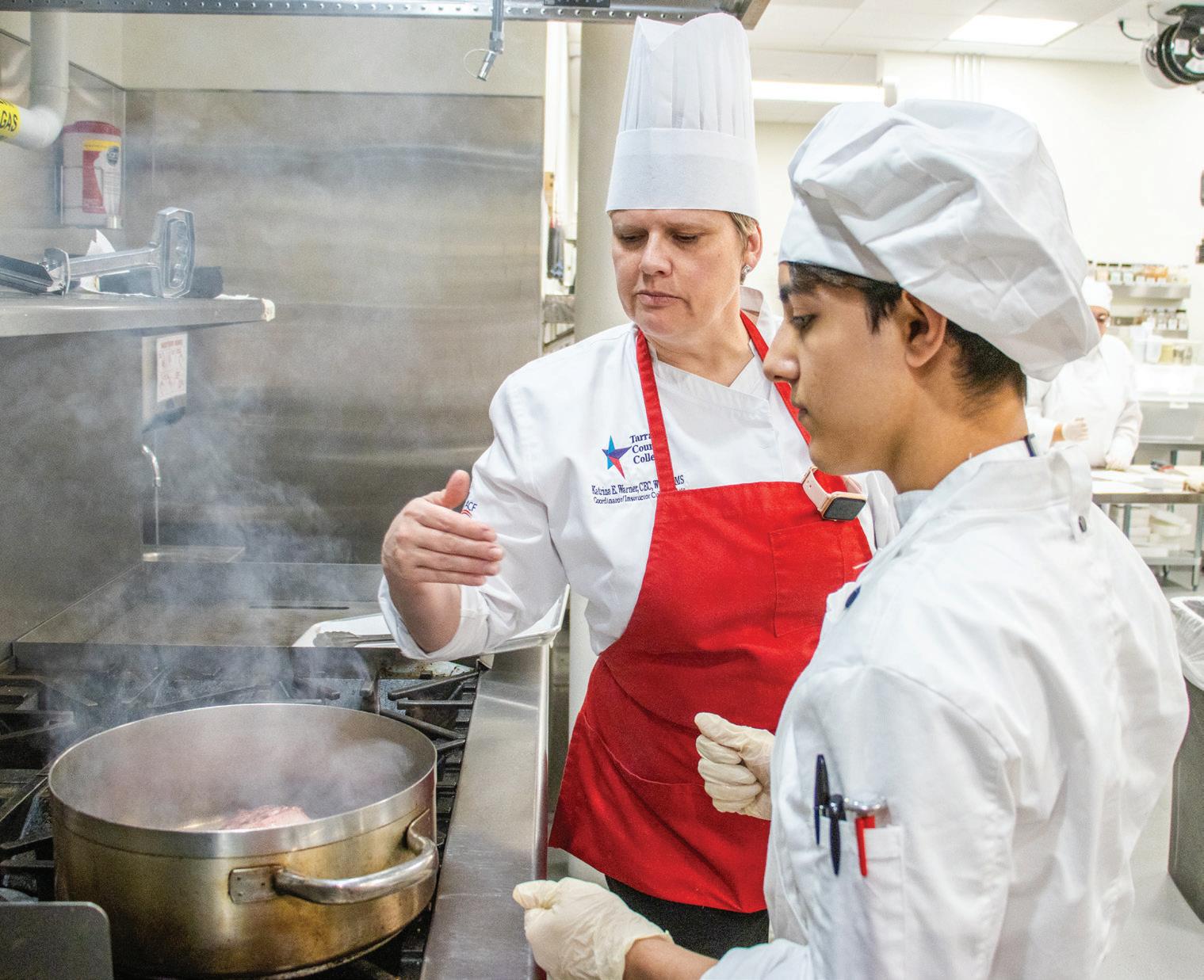
Warner’s award shows her dedication to her profession and her role as an educator. For TCC, it helps attract top industry faculty who can combine real-world knowledge with the curriculum.
“Not only is it important for our students to gain the skills, she and fellow faculty member in the program do a great job of upgrading their skills and making sure they’re prepared to work in the workplace,” Bowne said. “But then the partnerships with

Weeklong event honors community military members, first responders
CHEYENNE SHAWN
campus editor
cheyenne.shawn@my.tccd.edu
People gathered to honor the men and women who have served in the military with a series of Veterans Day events. From a parade held in Fort Worth to a 6.2 mile march around Marine Creek at NW campus, these celebrations brought people together in spirit of gratitude and remembrance.
Monday, Nov. 11, the annual Veterans Day parade took place. Local veterans, first responders, middle and high school JROTC students and community groups participated with marching bands and vintage military vehicles.
“We want to say thank you to those that fought so that we can have a free country,” Connie Cooper said.
As the parade passed, many were seen clapping and waving American flags showing their appreciation to those who served.
Later in the week, more people gathered to participate in a 6.2 mile walk around Marine Creek Lake to show their support for veterans and first responders. They were able to
be outside exercising surrounded by sunshine and greenery.
Reflecting on his past when he was in the Army, NW instructor Rodney Pearson organized this event as a throwback to the days when military members would ruck, an exercise that involves walking a set distance while carrying a weight in a backpack or marching in ranks.
“I thought it’d be a great idea during Veterans week to put this on to honor veterans and first responders,” Pearson said.
TCC student and marine veteran Patrick Longoria wore a gas mask while he walked the 6.2 miles to replicate his time in service.
“In addition to being the vice president of Student Veterans Association, I also just felt like it’s the very least I can do to show support to my brothers,” Longoria said. “It’s not just for veterans; it’s the first responders and active duty.”
Faculty member Cindy Allen and her two dogs completed the entire walk in honor of her two uncles who served during the Vietnam War, as a way to feel connected to them.
“When I think of Veteran’s day and I think of events, I come with both uncles in my heart,” Allen said.
Veteran resource centers at each campus held their own variety of events for Veterans’ Week, such as a luncheon, a one man play about military members and resource fairs that offer services for military and veterans.
Whether participating in events or volunteering, we play a role in ensuring that veterans services are not forgotten.
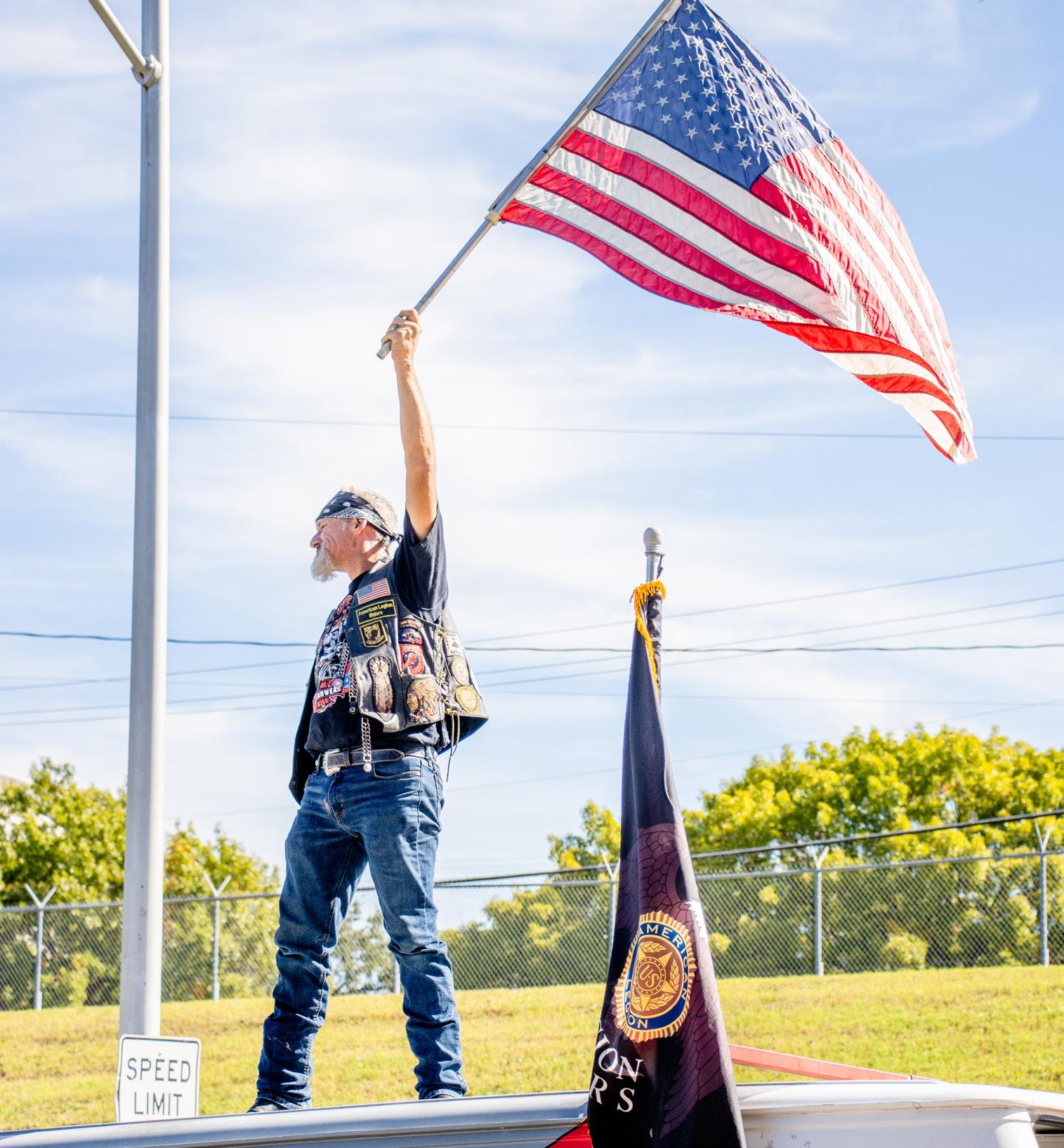

CHEYENNE SHAWN campus editor cheyenne.shawn@my.tccd.edu
A Veteran’s Day event focusing on Native American code talkers during both world wars celebrates the legacy of those whose service remains an important part of military history and Native American Culture.
This presentation highlights Native American tribes like the Navajo, Choctaw and Comanche who played a pivotal role in securing U.S. military communications by using their native languages to create unbreakable codes.
Dr. William Meadows, Professor of Anthropology and Native American studies at Missouri State University, discussed the history and significance of these code talkers.
He detailed the challenges that each tribe faced such as intercepted messages and ineffective coding methods and how their languages provided a secure alternative during World War I.
Native American code talkers faced several challenges between both wars.
During World War II, the military had hesitated to expand the code talkers’ program, but the Marines formed their group. The Na-
vajo developed over 700 code terms, while other tribes like the Comanches and Hopi used their languages for secure communication.
During this time Natives were being pushed into boarding schools that discouraged them from using their native language.
This shows the importance of code talkers’ contributions, despite the lack of official recognition and the challenges they faced.
“I think the fact that Native American languages were not done away with and that they are being able to be used in a time of combat like WWII,” said TCC Connect campus instructor, Chloe Northrop. “This is a really powerful story.”
This presentation brought on new information for the few that attended. We are still learning more about code talkers.
Recognition was slow for these men who served as code talkers. For the Navajo, they tried keeping their language a secret, but leaks occurred. Choctaw and Comanches were recognized by the state of Oklahoma in the 80’s. Federal recognition came in 2002.
“I think of resilience, survival and ingenuity,” Northrop said. “It makes me hope ... that people are still keeping up with these languages.”
VR set-up for a video game. Inside, students practice with large screens in front of them, shifting through different types of flying situations.
“This is what the pilot is seeing,” Natalie Shrestha, a career adviser at the center, said. “The student is learning how to navigate, understand where they are in location to a map, how many thousands of feet off the ground, making sure they’re not going to run into your buildings or mountains. That’s one of the most crucial skills.”
Savannah Lejeune is a student who uses the simulator for her degree program. The simulator can replicate full engine failures.
“Like if I pulled the engine up, oh my god, that engine just died,” she said. “And then you just pull idle ... and hopefully it would be in the grass and not in, like a fence or another plane or something.”
Their newest program is nondestructive inspection, testing and evaluation. Shrestha said the degree deals with seeing if something was built correctly.
“I like to describe it as the medical industry, but for people who hate sick people, needles, or blood,” she said. “Students are learning how to use sonograms and X-ray machines.”
The pilot and maintenance programs currently have a one to twoyear waitlist. Michael Esquivel, dean of business industry, said there are plans to expand the program to accommodate the growing industry demand. Esquivel said almost 100 students aren’t able to join the program each semester due to space.
“We’re looking at purchasing equipment, hiring faculty, creating a
degree path or training for air traffic controllers,” he said. “Those are examples of increasing capacity with our current program and adding new training opportunities.”
Instructor Raymond Bacon has been with the aviation maintenance program at the center for 18 years and said students walk away from the program being able to do something meaningful with their hands.
When we’re teaching them something, it’s not something that they can just learn and forget.
David McGarity Chair of professional pilot program
“Watching a student go from zero knowledge and skill into being able to pass the written test for the FAA and then actually get hired by a company locally or nationally, that’s the coolest part,” he said. “The students actually understand electricity. They understand physics, hydraulics, pneumatics, mechanical engineering, electrical.”
He said it can be overwhelming for a student to adjust to the workload. The progressive and repetitive classes build upon each other with the skills being learned in one class used in the next one.
“If you didn’t pay enough attention in science class in high school,
(continued from page 1)
inseparable since I first started working there,” Hodges said, “and so we spent a lot of time, like vacations and holidays and time off together.”
Warner’s relationship with food goes beyond her work in food services or teaching. She believes that food can also take a holistic approach in her professional and personal cooking.
electricity is likely to baffle you,” he said. “But we use that as kind of a test that your first term is going to be your toughest. After that, it becomes more and more hands-on, so that by the end of the two-year program, it’s less theory and far more hands-on.”
Bacon said the maintenance classes are less focused on theory and more on practical application.
“You’re showing them by example how to think critically, how to disregard distractors, how to troubleshoot with the most likely cause and then cure it,” he said. “I don’t know of any curriculum, so it is strictly by example and by experience.”
Though some may find the course load overwhelming, instructors make accommodations for students who may need them.
“I was talking to a student that was having problem getting her landings down right at the beginning, and after talking to her for a couple minutes, I realized she needed to have a cushion that she sat on because she was a little bit shorter than most of the other students,” McGarity said. “Once she could see clearly over the dash, she was able to get her landings down on solo.”
McGarity said all the instructors are extremely experienced in the aviation industry. Esquivel said instructors even stay after work to help students achieve their goals.
“When we’re teaching them something, it’s not something that they can just learn and forget,” McGarity said. “It’s something they will use in their career for the rest of their life.”
Aramiz Brooks contributed to this report.
sugar for honey, stevia, or monk fruit.
Q: “What is your favorite thing about Thanksgiving?”

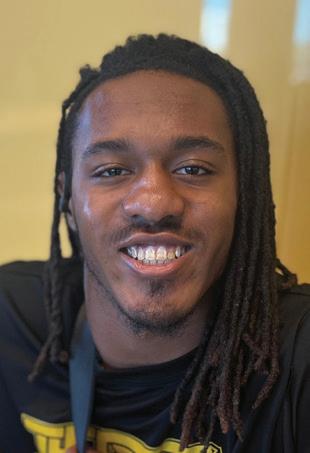



Cassandra Kerley NE Campus
“My favorite thing is going over to my extended family’s house and eat their food so I don’t have to cook. [My family] isn’t in a general area, we’re all spread out. I’m excited to see family that I haven’t seen in a year.”
Colin Dixon NW Campus
“The camaraderie that I have with my family ... for the past couple of years, I’ve been able to do it with my family. Just have time, cook with them, talk to them about life and anything choices that they make.”
Yoel Johnson SE Campus
“My grandma died this year... and it’s kind of a good time to [get together], especially [after] something like that when everybody’s kind of hurting. It’s a good time for everybody to get together, you know, some healing.”
Emmanuel Sofoluke South Campus
“This is my first Thanksgiving here in America, so I don’t know really. But then a lot of people say it’s very fun and all that. So probably the food, and the chicken.”
“We feel like we could have extended his life if he had been eating better,” Hodges said. “So, she is very adamant about making sure that she is making healthy choices.”
Warner feels it’s important to have the food people love but make healthier substitutions, like substituting regular
Hodges said Warner always tries to add more healthy options to their curriculum, such as gluten-free and sugar-free foods. This became more evident after Warner and Hodges lost a good friend to whom Warner dedicated her ACF award.
“I am so highly against, so highly against processed food and fast food,” Warner said.
Warner’s family practiced traditional family dinners with everyone around the table, which is a habit that she does with her own kids now.
“Every Sunday, I make dinner,” she said. “They can invite friends. If the neighbors want to come over, they can, it’s whoever wants to come over.”

Grace Behrens South Campus
“It’s my grandma’s potato casserole. I was hesitant my entire life to try it because it looked weird, but it’s actually the most delicious thing in the world.”
Reckless damage or destruction of property reported on NE Campus in the Science Building.
An unattended vehicle was hit on SE Campus on Nov. 4th and the report is now being investigated.
A vehicular collision resulting in injuries was reported in parking lot E on SE Campus.
The failure of a person to stop and render aid after an accident involving injury was reported in parking lot E on SE Campus.
Nov. 13
An unattended vehicle was hit in parking lot E on SE Campus.
A reported theft of property, valued at less than $750, occurred Nov. 12th on NE Campus in the Health and Physical Education Building.
Nov. 14
An unattended vehicle was hit in parking lot F1 on NE Campus. Nov. 7 Nov. 11 Nov. 12
HUDA QURESHI managing editor huda.qureshi@my.tccd.edu
The spiraling chaos of the impromptu Vegas wedding between Ivan, a hedonistic Russian pretty-boy swimming in his father’s money, and Ani, a charming sex-worker hustling to survive, is the perfect picture of fairytale romance gone wrong.
My favorite scene in “Anora” felt like it was dipped in glitter, Ani and Ivan stepping out of the chapel with their marriage certificate. Passerbys are met with a breathless: “We just got married!” as Ani flaunts the ring on her finger as proof. They’re so excited they can barely walk, holding onto each other for support.
The accompanying needle drop helped create the heart-spiking rush of being young, impulsive and so very certainly, without an inkling of doubt, in true love. The song, “Greatest Day” by Take That, isn’t even my taste, but it was so perfectly paired with the scene that I’ve been listening to it to chase the heart-spike.
However, the pixie-dust does wear off. Once Ivan’s parents find out about the marriage, they are out to get it annulled at all costs. To them, their son has brought shame to their family name by marrying a sex worker, and well, it’s status above all else.
Their first line of defense is to send three yes-men to essentially capture Ivan. After that, it’s a wild goose chase full of comedic beats.
It’s as funny as it is heartbreaking watch-

ing their Vegas night crumble into just another bitter memory. By the end the audience is left wondering: Did we expect something else? The two young lovers in question have a wealth disparity beyond understanding. And that’s a big deal.
Ivan throws money around like it’s just toy currency. Like he’ll never run out of it. It means drugs, alcohol and expensive clothes for his party that never ends, as long as he avoids his parents. His independence comes with an immunity to consequences, and it shows in his childlike attitude and constant impulsiveness.
Ani isn’t afforded this immunity. The opening scene of the film is in a club with sex workers picking up clients and taking them to private rooms. We see the women topless and giving lap dances, but it’s very clear that it’s nothing more than a job to them. Ani works the club with ease, with the goal of earning enough money to get by.
The first time Ani comes to Ivan’s mansion, she’s taken aback. She comments on the luxury of the amenities, but Ivan has an indifferent attitude towards them. In the end, Ivan’s superfluous wealth is what gets in the way of their relationship blossoming.
Sean Baker has explored the reality of working-class Americans before in films like “The Florida Project” and “Tangerine.” Each film humanizes its characters while also straying away from the glamorization of the reality of their life.
“Anora” is no different as Baker gives Ani the nuance to exist as a messy, brash, brave and, most of all, valuable woman while never discrediting her position as a sex-worker.
Mikey Madison is a star as Ani. She brings out the life of the character from being loud with a bite (literally) to being hopelessly romantic. She creates someone real by the end of the film, a figure many can find comfort in.
The ending will hit audiences bluntly and unexpectedly. Is a happy ending ever possible? Maybe not, but there’s still another day and that has to be enough.
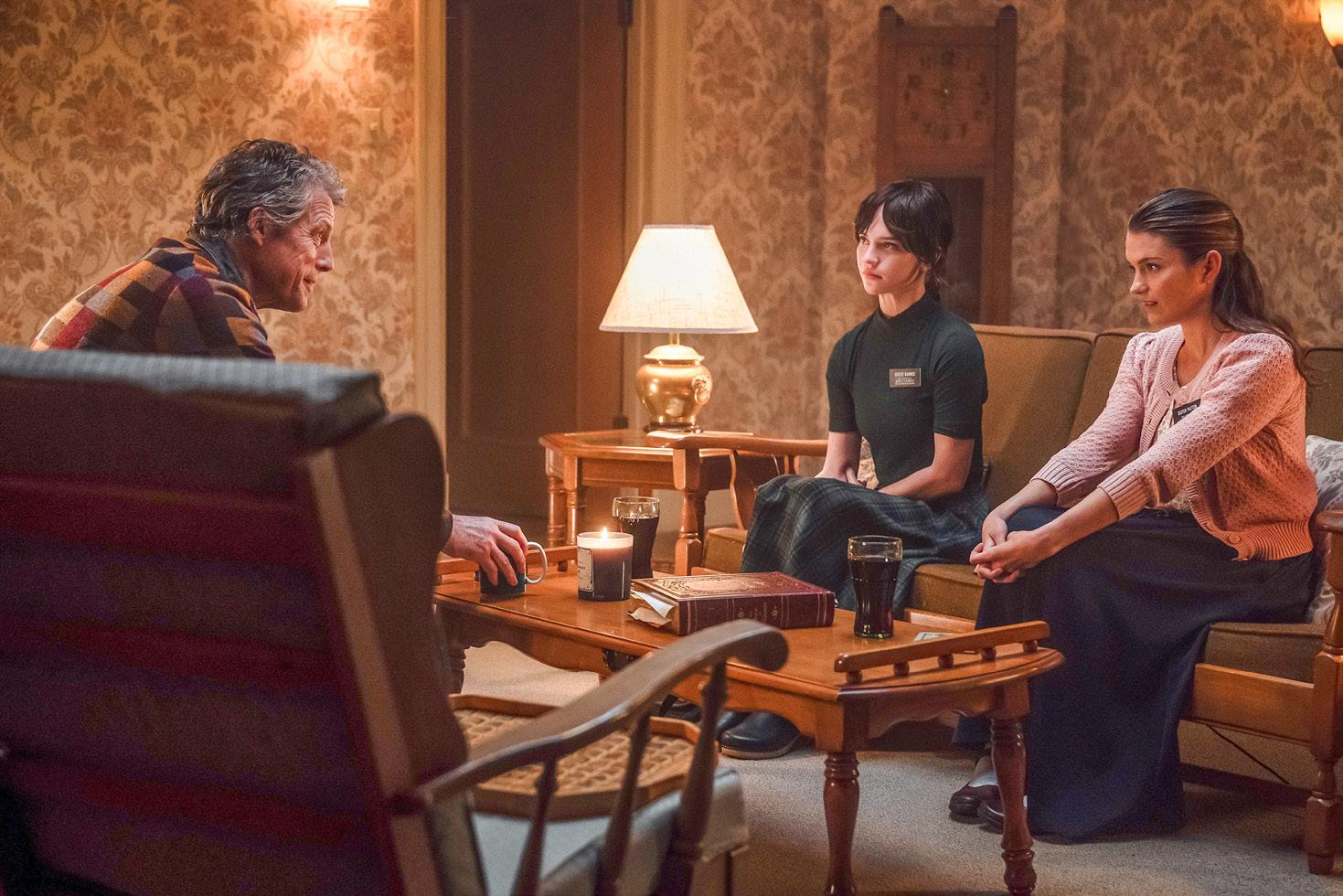
French/AP, A24 Hugh Grant as Mr. Reed has a tense conversation with Sister
Thatcher) and Sister Paxton (Chloe
‘Heretic’
FRED NGUYEN campus editor collegian.editor@tccd.edu
When you think of a Hugh Grant film, a psychological thriller with religious commentary probably isn’t the first thing that comes to mind.
Grant is famous for his bumbling, selfaware protagonists whom audiences always root for in movies like “Notting Hill” and “Four Weddings and a Funeral.”
Yet in “Heretic,” the rom-com legend shines as the charming but fanatical villain and shows just how effective casting against types can be.
The film starts with Sister Barnes and Sister Paxton, two Mormon missionaries played by Sophie Thatcher and Chloe East, visiting the home of Mr. Reed, played by Hugh Grant. They are invited into his isolated house to get out of the rain.
At first, they are just as charmed by Mr. Reed as the viewers. As they begin noticing Mr. Reed’s strange behavior and uncomfortable questions about their faith, the two missionaries find that they are trapped inside the house for the night and unable to escape Mr. Reed’s plan to use them for his own theological experiment.
for audiences.
The amazing performances did not stop with just Grant.
Thatcher and East play characters that have rarely, if ever, been played before, and they do it perfectly. Sister Barnes and Sister Paxton’s friendship was the bond at the core of the film and effectively delivered the human element to the story, which mostly concerned itself with questions of the intangible.
The film is concerned with why humans follow religions, and Mr. Reed spends the film arguing against every religion along with criticizing religious institutions.
Sister Barnes plays the important role of being Mr. Reed’s opponent in his arguments. She is more active than her companion in almost every decision in the film and often seems to be able to outsmart Mr. Reed.
That’s not to say Sister Paxton was an absent player. Her reaction to the trauma of that night was to “fawn” instead of Sister Barnes’ “fight.” In between the intellectual duel, Sister Paxton is the voice of the audience and the faith of the common person in contrast to the more scholarly Sister Barnes and Mr. Reed.

There have been many iterations of the dreamy villain, but casting an actor that viewers will automatically associate with pleasant memories was an excellent way to inject tension into the exposition.
Mr. Reed at first seems to be your typical Grant character: He is faintly exotic in his British-ness when surrounded by American characters and just as handsome as he was decades ago. The thrill of seeing how the film unmasks his character’s likable exterior and reveal his true motives is a treat

The film’s strength is in its performance and how it builds the message. “Heretic” is more a scathing commentary on the misuse of religion to control people more than it is about attacking faith.
The film does suffer a little from tiptoeing around the main message for too long, but it’s a minor trade-off for an interesting final reveal.
The tagline itself condenses the main message: “Question everything.”
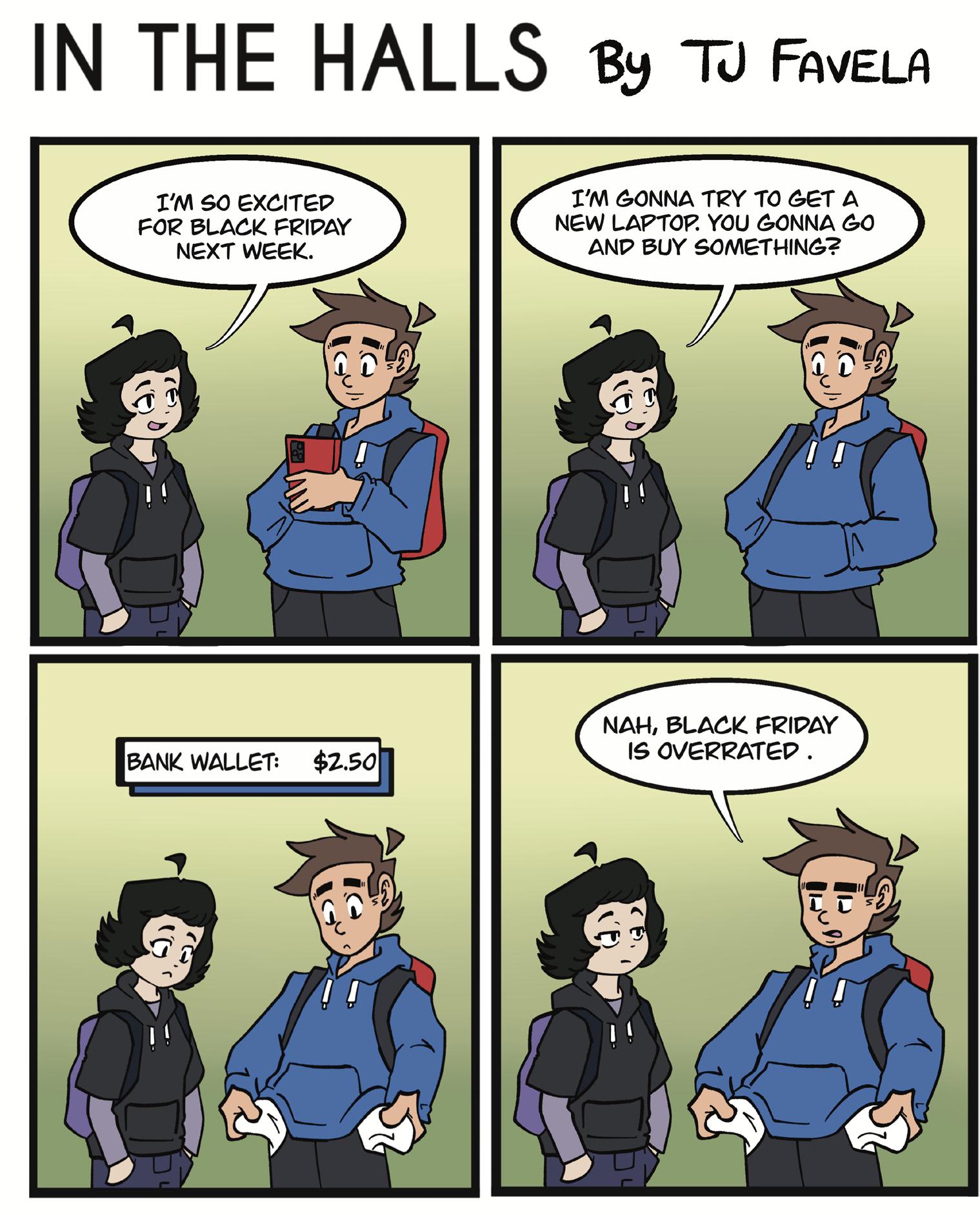

Thanksgiving Day, what traditionally was a time for family to come together, eat and express gratitude, has disconnected from it’s customs and become an unsettling gathering notorious for controversy.
The story of pilgrims celebrating a successful harvest with indigenous people is a facade to the horrendous history of America’s past. Knowing the mass genocide of native tribes was done by the hands of our ancestors makes commemorating this day by overindulging on turkey seem distasteful.
Forgetting the undeniable past to have a meal with relatives is easy in thought, but a divide has formed between families.
Political ideologies are a reason for people to refuse visiting one another. Previous discussions with family members that provoked heated debates at the dinner table have caused individuals to reconsider how they spend their day.
In the past 10 years, we’ve observed families disintegrate because of politics. Bloodline camaraderie has been abandoned and now more than ever, people are uncertain of what to do.
While one could use the time for rest, it is hard to relax while knowing what the day used to be.
Waking up to the aroma of green bean casserole cooking in the oven, sitting around the TV with siblings in pajamas watching

the Macy’s Day Parade, throwing around a football with cousins while the game was on, dressing up in new clothes mom purchased only to get them dirty with gravy and running towards your grandparents as they walked through the front
After 20 minutes of mixing, diluting and agitating liquid inside a canister full of secrets, I remove the long-slippery negative from its enclosure as the intense-florescent lights gleam onto the images and expose for the first time what I had captured.
Film photography, known by many for its tedious labor, is my passion. I remember the first time watching a blank piece of white paper slowly manifest an image I took, and it left me mesmerized.
The anticipation turning in my stomach throughout the entire process is an adrenaline rush I don’t receive from anything else. And contradictory to the thrill, it’s taught me how to be patient and kind to myself.
It seems simple to just press a button and seize the world’s movement in a still image, but there is much more to ensure before doing that.
door.
The day gave us a sense of belonging, where we gathered with our community and laughed and loved. But now we struggle to find peace within the communities of our past.

ASH PETRIE campus editor collegian.editor@tccd.edu
If inspired by what I see, I lift the camera, place the view finder to my eye and focus the lens on my subject. Then I must adjust the f-stop and aperture of my camera according to the subject’s lighting and the film’s ISO being used.
Once I’m confident of the settings chosen, the picture is taken. This process must be quick though because I can’t pause time, my camera does. But I can’t be careless with my decision or else the photo won’t come out right.
Adjustment and click after adjustment and click, the suspense builds up until the roll of 36 photos have been exposed. Even then, it’s still unknown if the choices I made captured the image how I wanted.
These fading memories of our kinship hold the thread of love remaining for them. However, one more uncivil encounter with these individuals could be the last snip tearing the relationship apart.
The 20-minute developing process can be haunting. Silently, I’ll reassure myself that there must be at least one perfect photo. As I pour the last rinse from the container, remove the strategically rolled film, and lightly glide my fingers from top to bottom of the five feet of negatives, I finally see my work.
My first year of shooting film made me frustrated. I made careless mistakes and lost multiple rolls of film due to inaccuracy. I wanted to give up many times, to sell the Minolta and throw all the film away.
But there would always be one picture hidden between the remaining 4.95 feet of black so beautiful it kept me dedicated to the art of film photography.
It makes me live in the moment, I don’t have the storage of an iPhone nor the power to delete. I take pictures of the people, architecture, objects and shadows that inspire me. I view the world at a different angle, literally, you can find me with my camera laying upside down in uncomfortable corners of the world just to take a photo.
However, it’s the uncertainty of whether
Deciding to separate oneself from family on a day dedicated to unity can feel isolating. But it seems more reasonable than planning to engage in a grueling day of intolerable conversation with family members.
Instead of focusing on bloodline, one should find their family in friendship.
Friendsgiving can replace the tarnished holiday. People coming together who value and respect one another to give thanks and recognition to the many blessings from the past year is what the day is for.
Whether or not one has a huge family, group of friends or one person to gather with won’t change the effects of celebrating Thanksgiving.
Expressing gratitude towards others is a way to find positivity during ominous times. According to Positive Psychology Research, it has been proven to alleviate stress and improve how one deals with adversity.
So, find your community. The people who can make you smile when you want to cry and cry because you’re laughing too hard. This week off is well deserved and should be spent celebrating all your accomplishments from the fall semester surrounded by the people who supported you through it. Take care of yourself and know there are people on campus who you can find a community with.
Plastic surgery has its place, but at what cost?
Most people across the globe have thought about cosmetic surgery at one point. Breast enlargements, face lifts, Brazilian butt lifts (and breast reductions…the list goes on.
Plastic surgeons advise their patients of possible complications. But if they happen to you, are you prepared for the outcome?
I found myself on the side of necrosis after I had a breast reduction two years ago. Necrosis is when living tissue dies. It affected the way I viewed myself and caused me to have body dysmorphia, which occurs when a person becomes overly concerned about an aspect of their appearance. Complications occur in 1% to 5% of plastic surgeries. The number can go up with more invasive surgeries like Brazilian butt lifts and breast reductions.
Doctors handle complications in different ways. A referral to wound care is common because wound vacs are used to aid in the healing of the open areas.


REBECCA CHAMPLIN campus editor collegian.editor@tccd.edu
Some people may develop a reaction to the adhesive used to close the incisions. This happened to me, causing blisters to develop over every incision. The doctor did not prepare me for the psychological effects of the surgery either.
If people knew how exhausting complications can be, they may not be as quick to jump down the plastic surgery rabbit hole.
A television show called “Botched” be-
came popular, showing Hollywood surgeons fixing bad plastic surgeries. Even after the complications, the “Botched” people hop right into surgery.
Society may have something to do with that.
In the age of air brushed pictures being shoved down our throats, the societal norms of beauty have changed. Celebrities and companies can transform the way a person looks with the click of a mouse.
In 2011, Julia Roberts modeled for Lancôme in an anti-aging products campaign. The ad was banned in the United Kingdom for advertising unrealistic outcomes for people.
The Kardashian and Jenner clans have openly admitted to plastic surgery. Kylie Jenner has spoken out about how she is working to shift her views of what beauty should be. She said motherhood has changed her thoughts on the subject.
Society should be more accepting of the aging process. Celebrities like Meryl Streep,
or not the photo even worked out that taught me the most. If I develop a roll just to discover nothing was in focus, everything was over exposed or that the ideas I had didn’t work out. I am not mad anymore because I still took those photos.
I’ve learned how to love my blurry and under exposed images because they still have a story. I am capable of learning from my mistakes, that isn’t hard, but choosing to love them even after recognizing the problems is. The ability to appreciate our mistakes and care for them is a form of self-love I believe everyone should learn.
I am proud of who I am today, and I wouldn’t be this person without my failures. While past decisions I made caused a lot of issues, I’ve grown to love the reckless young girl I used to be and the terrible photos she took.
I’m glad I still have that Minolta I bought in 2016, and I still use it today to pause the world and live in the short moments that inspire me.
Cameron Diaz and Jamie Lee Curtis have openly spoken about aging naturally. Companies need to be realistic in advertising what their products can do. Taking a step away from social media can help. Not seeing airbrushed pictures every day may help someone struggling with their own feelings about themselves. If you are determined to have plastic surgery, do your research and don’t look for bargains. Do not leave the country searching for these procedures to save a few dollars. Make sure you are fully prepared for body changes and possible complications. Some people mourn their lost body parts. Prepare your brain to understand you will look different, and you may not care for the results. Research your plastic surgeon. Do not go into surgery lightly. Ask to see examples of their work.
Cosmetic surgery can be life-changing for some. Just make sure to do the legwork before you go under the knife.

FRED NGUYEN campus editor collegian.editor@tccd.edu
Heat blasted out when the kiln opened.
After being heated to 1,800 degrees in 45 minutes, the three red-hot ceramic pieces inside were pulled out using tongs.
They were placed in two buckets filled with newspapers to catch fire before Jacob Steed, adjunct ceramics instructor and sponsor of the NW Clay Club, slammed the lid on with gloved hands.
“It’s kind of anti-climactic at the end,” Steed said, “but in 30 minutes or so, you’ll be able to see what the glazes look like.”
This is part of an ancient Japanese process of making ceramics called raku firing.
It is also an example of how the Clay Club is literally catching fire.
The club has existed for more than two decades, but this is the first year it has been open to all TCC students. Steed has been the sponsor for two years and said the club has grown exponentially since it reopened after the pandemic.
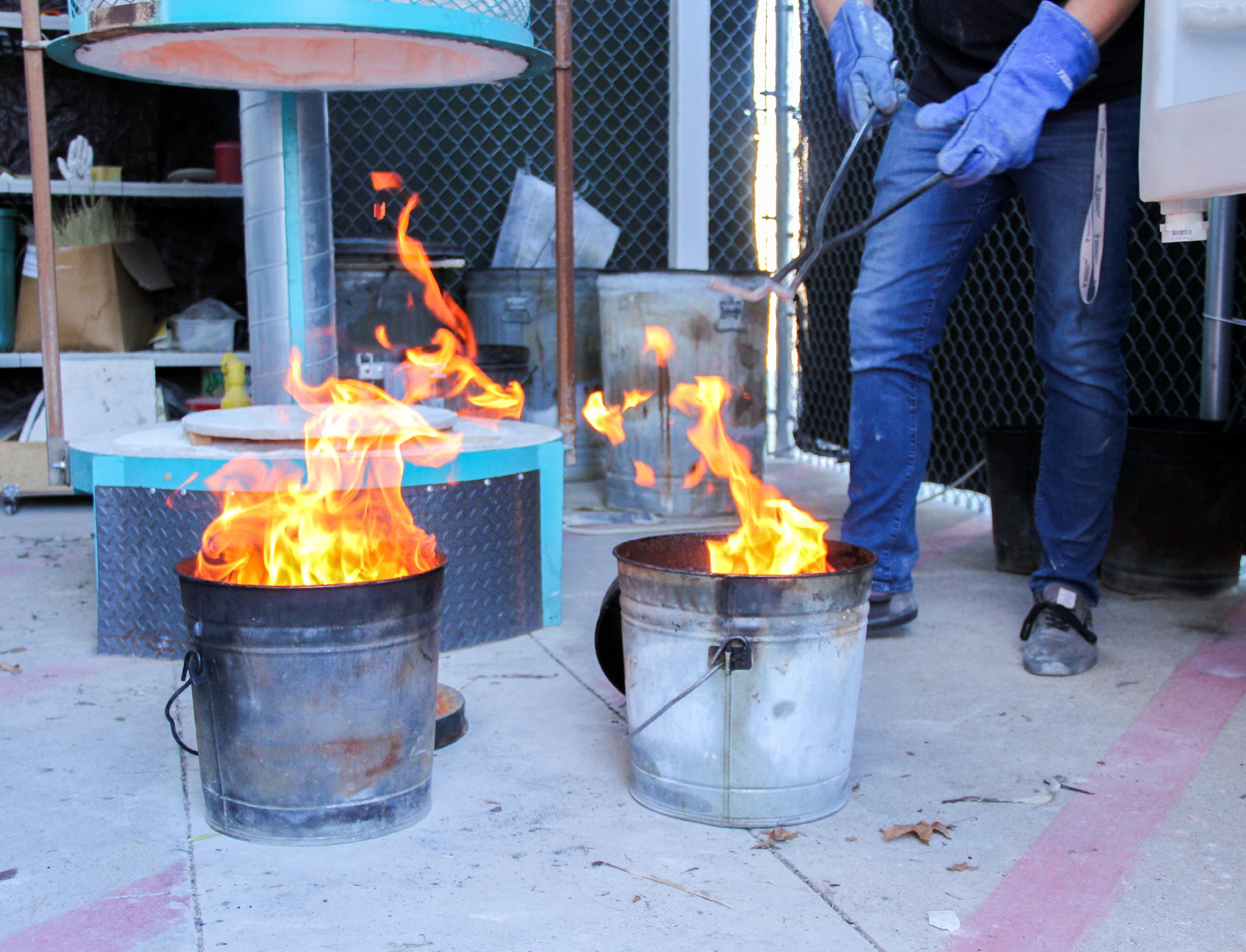
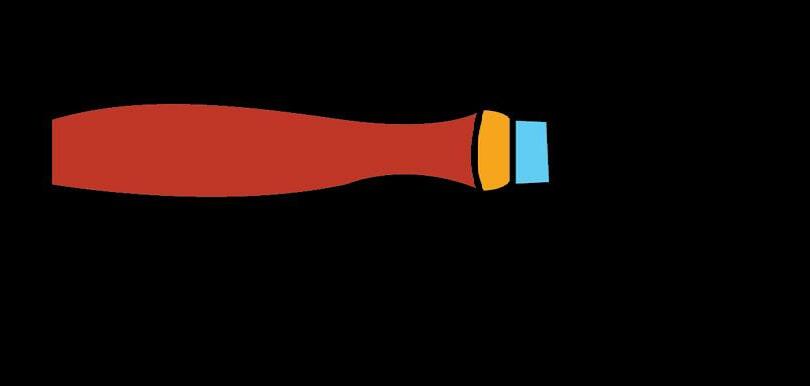
students in here, whether they’re in the [ceramics] class or not, doing something with clay,” Steed said. “Sometimes, we even have just people who work here come in and make things, and it’s been a lot of fun to see that growth.”
The club welcomes members of all ages and experience. It is also a way for students whose degree doesn’t necessarily require art classes to learn and make pottery.
NW student Sommer Ray is seeking a degree in environmental science but has grown to love pottery after taking a class over the summer.
“I’ve always been an art kid, but I’ve always also been on the verge of giving up art, I would say,” Ray said. “And so having a class where I have found a new output of art, and something that I feel a lot more aligned with, has really helped [me] feel like an artist again.”
The clay sale, which happens every semester, is an opportunity for ceramics students and club members to showcase their talents. It is where the best pieces of pottery can be purchased and has proven popular among TCC staff.
Preparations have already begun for the next clay sale, which will be on Dec. 3 - 4 in the NW05 lobby.
NW student and Clay Club president Thea Patterson said she has seen amazing work from students that were selected for
the sale. A student once asked for Patterson’s help in pricing some pieces that were going to be sold in last Christmas’ sale.
“She sits down, she goes, ‘Well I’m thinking $10.’ And I’m like, ‘No, sister. $30,’ ” Patterson said.
Everybody should have a creative outlet. ... It’s good for keeping you sane.
Mari Carlson NW student
Cups, mugs, plates and bowls are some of the most common things found drying on the shelves in the kiln room at the back


Functional pieces can be decorated with carvings or interesting glazes. NW student Emily Ponce took a simple vase and detailed it with dozens of swirling eyes all around its body.
She was an accomplished potter in high school and once took one of her pieces to a state competition.
When she came to TCC, Ponce vis ited the pottery sale and decided to take a ceramics class again.
Ponce said joining the Clay Club and having dedicated time to be creative has been therapeutic.
“I feel a lot more relaxed when I’m here, like I can just focus on [pottery,]” she said. “Like, no tests or other classes I’m taking. It’s just really relaxing.”
Many of the pieces created at club sessions also depict member’s favorite characters and media.
NW student Mari Carlson is working on a figurine of a character from the video game “Hollow Knight.”
Like Ray, Carlson is currently seek ing a degree in science but recently start ed attending Clay Club sessions to ex plore their artistic side.
“Everybody should have a creative

outlet,” Carlson said. “It’s good for keeping you sane.”
Associate professor of ceramics Fred Spaulding is a former Clay Club sponsor and is still a major contributor.
He said working with clay takes his mind off any issues and is meditative in its process.
“You might have a problem with your car, you might have a problem with another person, whatever,” Spaulding said. “But you’re focusing on an object. You’re focusing on manipulating a material with your hands. And so that activity becomes a focus for your mind.”
Just like any art, clay has its challenges. The draw of this medium is in the variety of ways one can turn something formless into an object.
Steed said the community aspect of the club encourages this creativity because clay is a humbling medium that reflects the creator’s mindset.
“No matter how many years you’ve done it, you could sit down at the wheel and just have an awful day and then, say this is like your second week doing [pottery,] just have a fantastic day,” Steed said.
